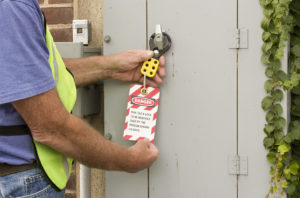October 10, 2019
Forward-looking safety
Improving safety performance means looking beyond past injuries
If you’re like many employers, you spend considerable time and money making sure your organization adheres to OSHA requirements. It may be tempting to view this as the finish line for preventing injuries, but in reality, maintaining a truly safe workplace means going well beyond compliance.
Establishing programs to comply with OSHA standards is definitely important, but stopping there leaves workers unprotected from the myriad dangers that haven’t been incorporated into state and national safety requirements.
“We recommend employers look beyond just the hazards that have been documented in the past,” said SFM Loss Prevention Technical Leader Lee Wendel. “If you rely on historical injury trends to predict future risks, you’re catching up instead of looking forward. A genuine commitment to safety means having the capacity to identify issues before they result in injuries.”
Since the federal government established the Occupational Safety and Health Administration in 1970, the rate of serious injuries and illnesses in American workplaces has declined sharply. The frequency of such incidents has dropped from 10.9 per 100 workers in 1972 to 2.9 per 100 in 2016, according to OSHA. Employers’ compliance with OSHA’s safety rules has played a valuable role in this improvement, but this is only part of the equation.
Performing risk analysis
“Moving beyond compliance and into ‘risk analysis’ is something the safety profession has been working on for many years,” Wendel said. “The first step is giving careful consideration to any risks that could be jeopardizing the safety and health of your employees.”
Traditionally, employers and regulators have concentrated on the risks that are rated high in both probability and impact. An example of this would be working on a sloped roof without fall protection. In this scenario, there is a good chance that over time, workers will lose their balance and fall off the roof. Without fall protection, the impact of falling of a roof is high because it will almost always result in severe injury or death.
This particular hazard would be covered by OSHA regulations and injury prevention procedures, but the same can’t be said for every risk that falls into the high-high category (e.g., tripping hazards that could result in a serious slip and fall injury). Identifying risks in this category that have not been addressed at your company is definitely the place to start, but it shouldn’t end there.
Moving safety performance to the next level means looking for less obvious risks that could result in high-impact injuries. These are difficult to predict when one depends on “lagging” indicators such as injury reports, OSHA Logs or loss runs. Identifying these risks requires a shift to looking for a “leading” indicator – a condition, behavior or situation that you can envision leading to a significant injury.
Examples of using leading indicators to prevent injury:
- Eliminating unsafe driving behavior before it results in a crash
- Responding to a forecast of snow by pre-treating walkways with brine or other chemicals
- Observing employees using ladders and educating those using them incorrectly
- Auditing the cleanliness in work areas and ensuring clean, dry floors
- Recording which employees use their PPE (personal protective equipment) and having a drawing for a prize on a regular basis
- Training employees on safe lifting techniques, even if they’re not lifting heavy objects frequently
- Asking employees about hazardous conditions – and then working together to solve the problem before an incident occurs
It starts with leadership
The most effective safety strategies engage the employees – they are closest to the details of their jobs and are most likely to know where the risks are. Effective leaders interact with their employees regularly and treat them as partners in developing processes and communication that support safety throughout the operation.
By cultivating an open dialogue about spotting risks, leaders have the opportunity to eliminate situations in which the principles of efficiency and safety appear to be at odds. For example, an employee working on a tight deadline may believe that there isn’t time to follow all the safety procedures. The safest workplaces are the ones in which nobody perceives an advantage in working unsafely.
“We encourage leaders to build an expectation of safety into the process of running the business,” said Wendel. “Leaders need to express the requirement that workers get the job done without getting anybody hurt while doing it – even if that means coming up with a different way of doing it.





